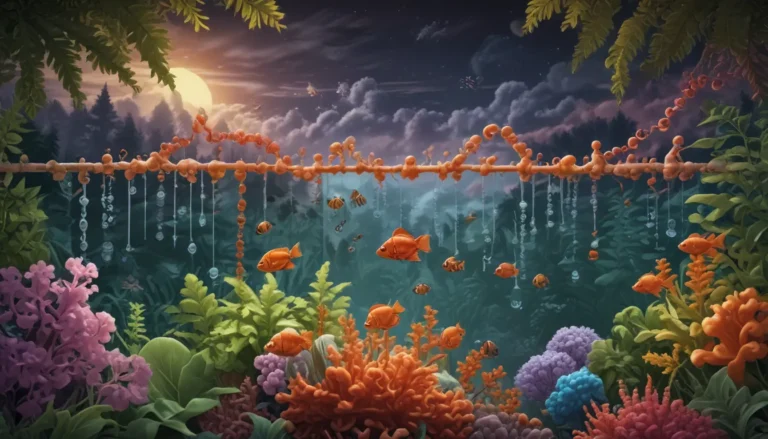A Note About Images: The images used in our articles are for illustration purposes only and may not exactly match the content. They are meant to engage readers, but the text should be relied upon for accurate information.
Embark on a captivating journey through time as we delve into the fascinating world of the fossil record. The ancient remnants of plants, animals, and other organisms preserved in sedimentary rocks offer a remarkable window into the history of our planet. Join us as we explore 16 intriguing facts about fossils, shedding light on the evolution of life, past climates, and the biodiversity of Earth.
Unveiling the Past: The Significance of Fossils
Fossils are like time capsules, preserving invaluable clues about ancient life forms, ecosystems, and Earth’s history. These remnants serve as tangible evidence of the incredible diversity of life on our planet, ranging from massive dinosaurs to tiny microorganisms. By studying fossils, scientists gain insight into the evolution of species over millions of years, unraveling the mysteries of Earth’s past.
The Chronicles of Ancient Life: Insights from Fossils
The fossil record provides a treasure trove of information about the history of life on Earth. Fossils, whether bones, shells, or imprints, offer tangible evidence of the organisms that once inhabited our planet. Through processes like mineralization and preservation in substances like amber, fossils are formed, allowing scientists to reconstruct past ecosystems, environments, and evolutionary changes.
Unraveling Earth’s History: The Role of Fossils in Science
Fossils play a crucial role in dating rocks and determining the age of Earth’s geological formations. By analyzing the age of rocks where fossils are found, scientists can track the development and diversification of species, revealing the evolutionary processes that have shaped life. The fossil record also sheds light on some of the largest and most iconic creatures that ever existed, such as the Tyrannosaurus rex and woolly mammoth.
Peering into the Past: Discoveries and Revelations from Fossils
The study of fossils has provided valuable insights into mass extinctions throughout Earth’s history, as well as human evolution. New discoveries and ongoing research continue to expand our knowledge of prehistoric life, reshaping our understanding of Earth’s history. Marine fossils, ancient corals, and shells offer insights into the evolution of oceans and the diversity of marine life forms.
Decoding Ancient Mysteries: The Power of Fossils in Paleontology
Well-preserved fossils reveal intricate details about an organism’s anatomy, behavior, and evolutionary relationships. Through the study of fossils, scientists can unravel mysteries surrounding the origin of life, the development of complex ecosystems, and the processes driving evolutionary change. Fossils found on every continent provide a global perspective on Earth’s past, offering insights into the history of climate change and the incredible diversity of life on our planet.
A Glimpse into the Past: The Diversity of Life on Earth
From the smallest microorganisms to the largest dinosaurs, the fossil record showcases the vast array of species that have inhabited our planet throughout its history. By examining fossils, we gain a deeper understanding of Earth’s past, present, and future. These ancient remnants serve as tangible evidence of the incredible journey life has taken on our planet, offering invaluable insights into the rich tapestry of life that has existed throughout history.
Unraveling Earth’s Mysteries: The Future of Paleontology
As we continue to explore and uncover new fossils, the story of life on Earth will continue to unfold, bringing with it new revelations and exciting discoveries. The fossil record remains an invaluable resource, allowing us to unravel the mysteries of our past and offering glimpses into the future of our planet. Through the study of fossils, we gain a deeper appreciation for the world we live in and the complex web of life that surrounds us.
FAQs
Q: What is the fossil record?
The fossil record refers to the collection of all known fossils, which are the preserved remains or traces of ancient organisms. It provides valuable evidence of past life on Earth and serves as a record of the history of life.
Q: How are fossils formed?
Fossils are formed through a process called fossilization, where the remains or traces of organisms are preserved in sedimentary rock or fossil-bearing materials. Over time, organic matter is replaced by minerals, resulting in the formation of a fossil.
Q: What can fossils tell us?
Fossils can tell us about the organisms that lived in the past, including their anatomy, behavior, and evolutionary relationships. They also provide evidence of past climates, ecosystems, and environmental changes.
Q: How old are fossils?
Fossils can range in age from a few thousand years old to over 3 billion years old, depending on the type of fossil and the geological context in which it is found.
Q: Where are fossils found?
Fossils can be found in various locations around the world, including sedimentary rocks, caves, ice, and marine environments. Sedimentary rocks have a higher likelihood of preserving fossils compared to other types of rock.
Q: How do scientists study fossils?
Scientists study fossils through excavation, analysis of their structure and composition, and comparisons with living organisms. Advanced techniques like CT scanning and DNA analysis are also used to gain further insights.
Q: Can fossils be found in every rock?
No, fossils are primarily found in sedimentary rocks, formed from layers of sediments that are more likely to preserve fossils. Other types of rocks may not have the same preservation capabilities.
Q: Are all fossils of dinosaurs?
While dinosaurs are well-known, the fossil record includes a wide range of organisms beyond dinosaurs, such as plants, insects, mammals, and microscopic organisms.
Q: How do fossils help in understanding evolution?
Fossils provide direct evidence of past life forms, enabling scientists to study changes over time and trace evolutionary relationships between species.
Q: Can fossils help in predicting future environmental changes?
Studying the fossil record provides insights into how organisms have responded to past environmental changes, allowing scientists to make predictions about future impacts on ecosystems.
Unearth the secrets of the past with fossils, unlocking the mysteries of Earth’s ancient history. Dive into the world of paleontology, where each discovery enriches our understanding of life’s evolution. As you explore fossils and their significance, remember that they are not just relics of the past but gateways to a deeper comprehension of the world around us. Join us on this journey through time, where each fossil holds a story waiting to be discovered.






